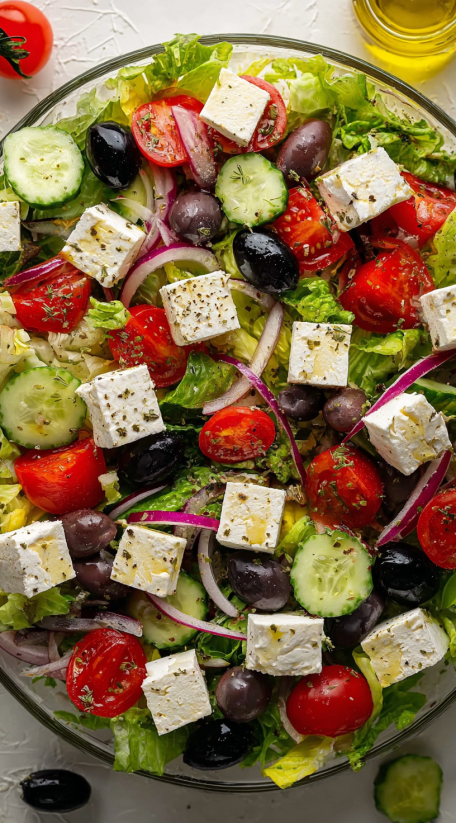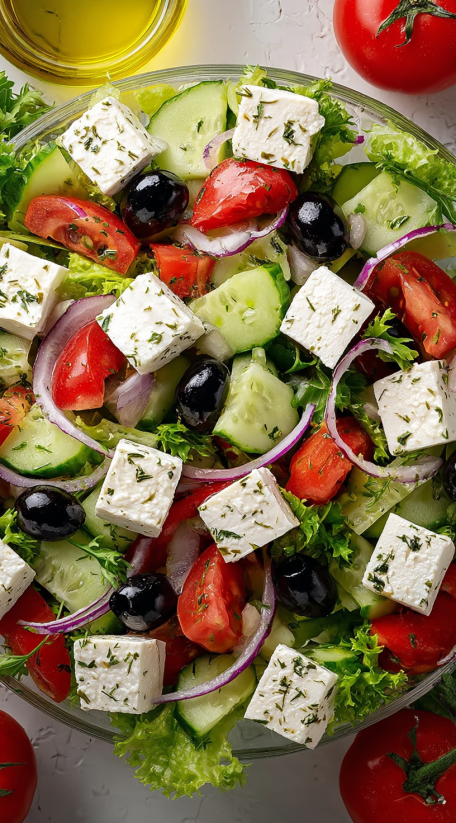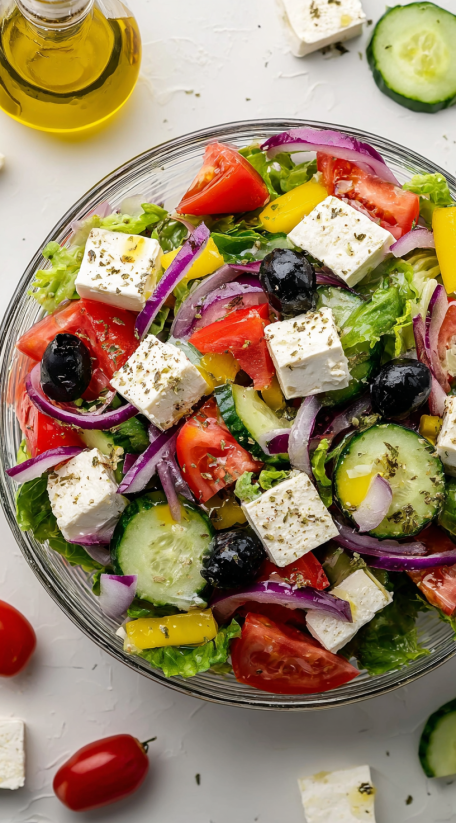 Bookmark
Bookmark
Greek salad Horiatiki is a longtime favorite in my kitchen because it brings together crisp vegetables, creamy feta, and briny olives for a bright and satisfying bite you can throw together any night of the week. I love how each ingredient shines, reminding me of a sunny afternoon in the Mediterranean with every forkful.
I remember making this for a potluck last summer and it completely disappeared before anything else on the table. Since then it has become my go-to for summer gatherings or a quick, fresh lunch.
Ingredients
- Tomatoes: Select the ripest, juiciest tomatoes you can find. Vine-ripened or farmer's market heirlooms have the richest taste and texture
- Cucumbers: I use seedless for less water and extra crunch. Look for firm, unblemished skin
- Red Onion: Adds sharp tang Although classic recipes call for thin half moons of raw onion you can soak them briefly in cold water for a milder flavor
- Green Bell Pepper: Choose a firm pepper with glossy skin. It provides subtle bitterness and great color
- Kalamata Olives: Go for pitted and deep purple black olives for true Greek flavor. They bring a briny savoriness that balances the dish
- Feta Cheese: Always choose Greek feta made from sheep's milk for authentic creaminess and just the right amount of salt. Block feta cut or crumbled fresh is ideal
- Olive Oil: Use extra-virgin Greek olive oil for the best aroma and finish
- Red Wine Vinegar: Select a quality vinegar for mellow acidity and brightness
- Dried Oregano: Greek oregano has a robust earthy punch. Crunch some between your hands before adding to wake up its aroma
- Salt and Black Pepper: Use sea salt and freshly ground black pepper to let the flavors sing
Step-by-Step Instructions
- Prep the Veggies:
- Wash the tomatoes, cucumbers, green bell pepper, and red onion thoroughly. Cut the tomatoes into chunky pieces, slice the cucumbers into thick half moons, cut the bell pepper into thin strips, and slice the red onion as thinly as possible. This keeps each bite balanced and colorful.
- Arrange in Layers:
- Spread the vegetables in a large shallow bowl or platter. Scatter the tomatoes, cucumbers, bell pepper, and onion so they are evenly mixed but not crushed. This helps the salad look inviting and ensures every forkful is flavorful.
- Add the Olives and Feta:
- Dot the salad with whole or halved Kalamata olives. Break or slice the feta cheese into big rustic pieces and lay them over the vegetables. This keeps the feta from breaking down and gives every serving a creamy, salty burst.
- Mix the Dressing:
- In a small bowl, whisk together extra-virgin olive oil, red wine vinegar, dried oregano, salt, and black pepper. Taste and adjust the acidity or salt if needed. The dressing should be vibrant but not overpowering.
- Dress the Salad:
- Pour the dressing evenly over the salad just before serving. Toss gently with hands or large salad spoons, being careful not to mash the feta or vegetables. You want everything coated in dressing while keeping the veggies crisp.
- Serve Fresh:
- Greek salad is best eaten immediately so all the flavors stay bright and the veggies retain their crunch. Serve as a main with some crusty bread or as a side for grilled fish or meat.
 Bookmark
Bookmark
My favorite part is biting into the creamy feta alongside the juicy tomatoes and olives all in one mouthful. It takes me right back to sharing big family meals on the patio during summer vacations in Greece.
Storage Tips
If you have leftovers store the veggies and dressing separately in airtight containers in the fridge to keep everything crisp. The salad will stay fresh for about two days but the tomatoes may give off water so toss well before eating.
Ingredient Substitutions
No Kalamata olives on hand Try black or green olives for a slightly different twist. Swap red onion for sweet onion or omit it if you want a milder flavor. For dairy-free use a vegan feta style cheese that crumbles well.
 Bookmark
Bookmark
Serving Suggestions
Serve with warm pita wedges or a loaf of good bread to soak up the juices. Greek salad pairs perfectly with grilled chicken souvlaki seafood or lamb. Sometimes I top it with chickpeas or quinoa for extra protein and a heartier meal.
Cultural and Historical Context
Horiatiki means village style and this salad was born from what was on hand in rustic Greek kitchens. There is no lettuce in the classic version just a pile of whatever was freshest from the market—always unpretentious but made with utmost care.
Frequently Asked Questions
- → What type of tomatoes is best for this salad?
Vine-ripened tomatoes lend robust flavor and firm texture, bringing ideal sweetness and acidity to the salad.
- → Can other olives be substituted for Kalamata?
While Kalamata olives are traditional for Greek salads, black olives can be used, though the flavor will differ slightly.
- → Is feta cheese essential, or are there alternatives?
Feta adds a tangy creaminess that defines the dish, but you may substitute with a similar brined cheese for variety.
- → Should the vegetables be peeled or left unpeeled?
For best texture and color, cucumbers and other vegetables are usually left unpeeled, provided they are well washed.
- → What is the ideal dressing for this salad?
A simple blend of extra virgin olive oil, red wine vinegar, dried oregano, plus salt and pepper delivers authentic flavor.
- → How should Greek salad be served?
Serve immediately after dressing for optimal crispness, as a refreshing side or light main course.
